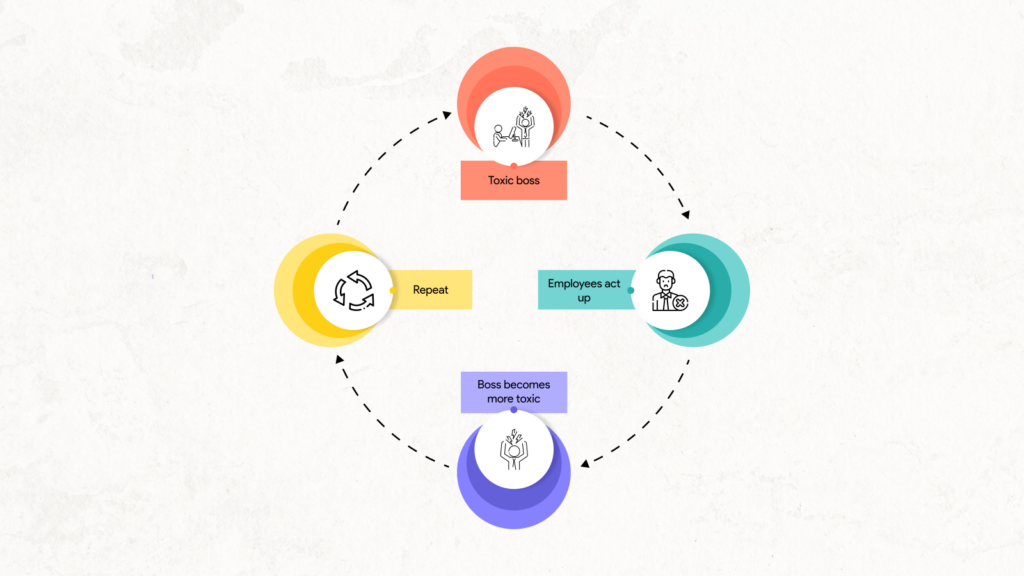Have you ever had a boss whose massive ego and angry outbursts made you dread going into the office? A leader whose toxic behaviour and hostility towards the team created an incredibly demotivating and unbearable work environment? If you’ve experienced a derailing leader like this, whose unchecked arrogance and inability to control their emotions sabotaged team morale and results, then you know first-hand how destructive derailing leadership can be.
Derailing leadership is a sinister force lurking in many organizations and refers to behaviours that hinder success and damage team dynamics. Imagine leaders prone to angry outbursts, prioritizing their ego over team goals, or resorting to manipulation. These actions chip away at trust, suffocate collaboration, and leave organizational goals gasping for air.
The consequences are stark: employees feel drained, disengaged, and even fearful, leading to high turnover and plummeting productivity. Collaboration becomes a forgotten dream, replaced by a tense environment where information sharing dries up like a desert spring. Unsurprisingly, achieving goals under such leadership feels less like scaling a mountain and more like trudging through quicksand.
Let’s understand how Derailing leadership can negatively affect the organization, Teams and individuals.
Leadership Hubris: Ego’s Role in Failure
John, a confident and charismatic CEO, launches a new product based on his vision despite concerns from his team about its market viability. Ignoring feedback, he pours resources into marketing. The product fails to gain traction, causing financial losses and eroding trust. John’s refusal to listen alienates his team and damages morale.
John’s behaviour aligns with characteristics of hubris syndrome. His excessive confidence in his vision and refusal to heed warnings from his team demonstrate a sense of invincibility and disregard for dissenting opinions, common traits of hubris syndrome. Despite evidence suggesting otherwise, John persists in pursuing his agenda, exhibiting a disconnect from reality and a lack of accountability. His actions ultimately lead to negative consequences for the organization.

John’s story shows a leader going totally off the rails. His big ego and not listening to others are classic signs of derailing leadership. Instead of changing course when evidence showed his product idea was bad, John’s pride kept him barrelling ahead. This led to the eventual crash. Derailed leaders like John remind us how arrogance and refusing feedback can send even talented leaders down a destructive path.
While derailed leaders exemplify the dangers of arrogance and disregarding feedback, their destructive behaviour can also manifest in the form of workplace aggression, which undermines leadership effectiveness and organizational success.
The Role of Aggression in Derailing Leadership
When it comes to anger in the workplace, we often think the danger lies only in situations where we get heated over a specific work issue. But what if I told you that even anger completely unrelated to your job can severely impair your leadership abilities?
A recent study has uncovered some concerning findings about the insidious effects of anger on decision-making and judgment, regardless of the anger’s source. Here are some key takeaways:
Distracted Focus
Anger is like blinders for your mind. It narrows your attention span, making it difficult to consider all the relevant information and perspectives needed to make smart choices. When you’re angry, you’re more likely to miss crucial details or overlook important angles.
Reduced Receptivity
Have you ever tried to offer feedback or suggestions to an angry colleague or boss? Good luck with that! The study found that angry individuals become far less receptive to others’ ideas, even if that input could be valuable. Their minds are simply closed off from taking in different viewpoints.

Biased Evaluations
Anger can also dangerously distort how we evaluate and judge those around us. When seeing red, we’re more prone to making unfair assessments of people’s performance, contributions and capabilities. This bias could lead to missed opportunities or pushing away top talent unnecessarily.
The implications are clear: if you want to lead effectively and make sound decisions for your team or organization, you need to get a handle on your anger – even if it has nothing to do with work. Finding healthy ways to manage those heated emotions could be the key to maintaining a clear, impartial and receptive mindset on the job.
Beyond the initial distraction and clouded judgment anger causes, its impact in the workplace goes deeper. Critical decisions made in the heat of anger are more likely to be flawed and lead to regret later. Anger also creates a ripple effect, breeding negativity within teams and hampering the very collaboration and problem-solving essential for success. Leaders who exhibit anger risk the most, as they not only suffer from these consequences but also erode trust, demotivate their team members, and ultimately hinder the overall performance of the group. In essence, anger in the workplace isn’t just a personal issue; it’s a poison that can slowly sabotage teamwork, decision-making, and ultimately, success.
Why Identifying Derailing Leadership Matters
We’ve all had that one boss who made the workplace miserable. The constant criticism, impossible demands, and stunning lack of empathy – enough to make anyone desperately search for a career exit.
But get this – destructive leadership isn’t just an annoyance, it’s an infectious disease that spreads negativity throughout an organization. A recent study found this toxic management style tanks employee job performance, creativity, engagement, and satisfaction.
Even crazier? How long you’re exposed doesn’t matter. Whether under a destructive boss for months or years, the fallout is equally potent.
But it gets worse. The study suggests that when employees start acting out by exhibiting deviance or counterproductive behaviours in response to a toxic leader, it actually triggers more destructive leadership tendencies. A vicious cycle is born:

Over time, this insidious loop poisons the entire workplace culture into a distrustful, unmotivated, unproductive mess.
The takeaway? Destructive leadership is very real and needs to be taken as seriously as any workplace hazard. A toxic environment doesn’t just affect physical safety – it profoundly impacts productivity, motivation, and even employee conduct.
Fixing it requires awareness of these destructive patterns and true accountability to address toxic tendencies head-on before they fester. Employees also need to be mindful that lashing out in response can inadvertently feed the cycle.
At the end of the day, a healthy, positive workplace culture benefits everyone. That’s why at PerspectAI, our leadership assessment tools measure key qualities like facilitating leadership, virtuous behaviours, and crucial derailing red flags.
Because protecting teams from viral toxicity and developing outstanding, constructive leaders is essential for any organization wanting to operate at its full, thriving potential.